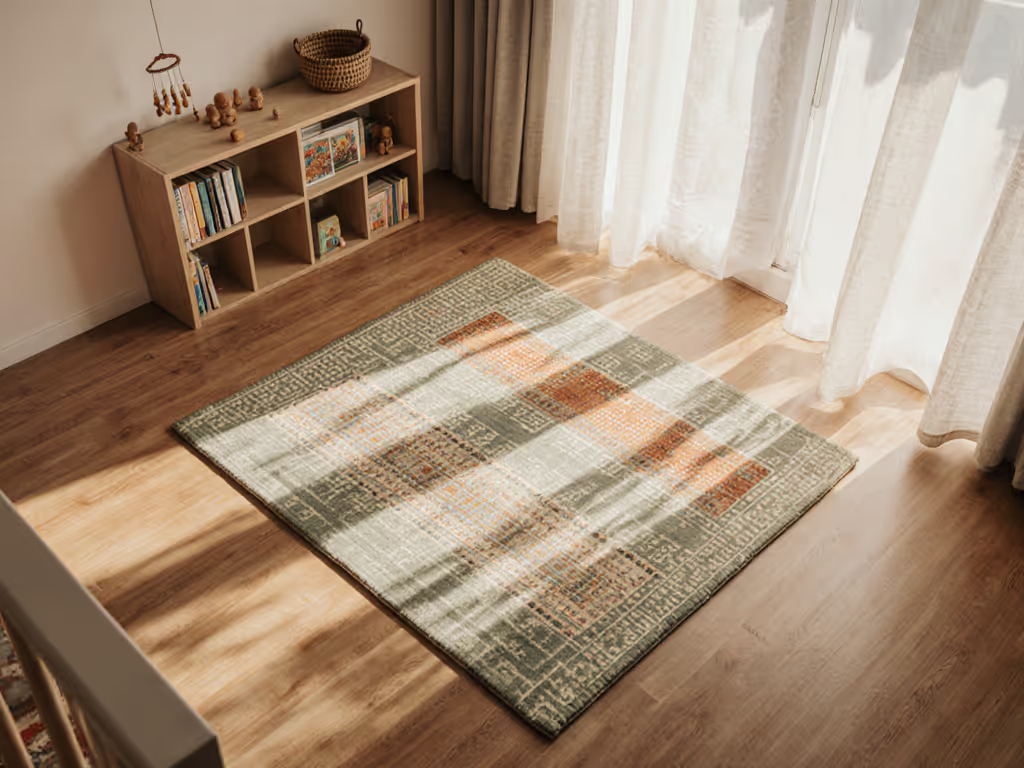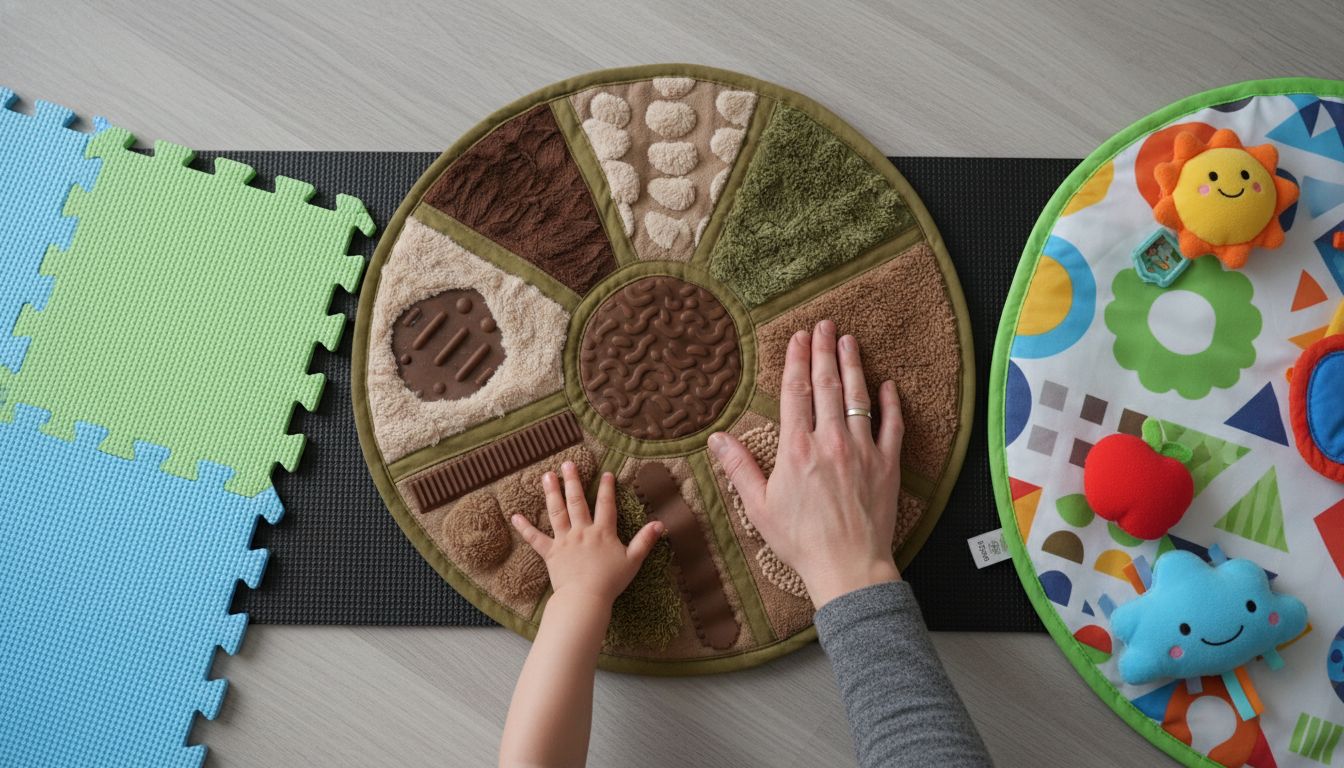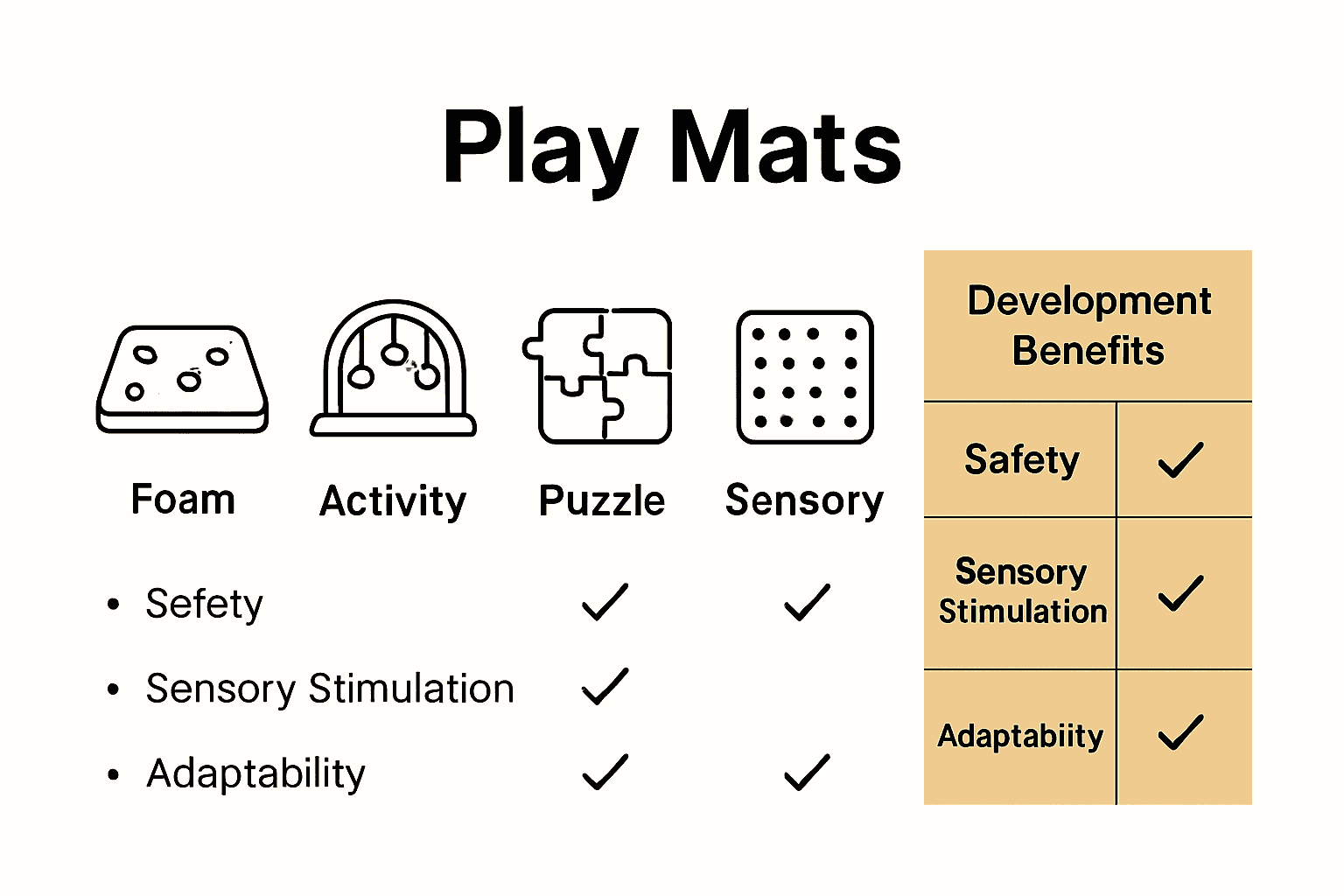
Complete Guide to Play Mats in Home Safety

Did you know that over 60 percent of childhood injuries happen at home during playtime? Creating a secure space for infants and toddlers is more important than ever as they begin to crawl, roll, and explore. Play mats do more than soften blows; they support healthy growth, prevent unnecessary accidents, and transform any room into a nurturing zone for active learning and safe movement.
Key Takeaways
| Point | Details |
|---|---|
| Safety and Development | Play mats are essential for creating safe, soft surfaces that support infant development through play and exploration. |
| Types of Play Mats | Different types of play mats cater to specific developmental needs, including foam, activity, puzzle, and sensory mats. |
| Injury Prevention | Properly designed play mats absorb impacts, significantly reducing the risk of injuries during early mobility stages. |
| Smart Selection | Parents should prioritize safety and developmental features over aesthetics and low cost when choosing play mats to ensure child safety and growth. |
Definition and Purpose of Play Mats
Play mats are specialized surface coverings designed to create safe, comfortable, and developmentally supportive environments for infants and young children. These carefully engineered floor coverings transform ordinary spaces into protective zones where little ones can explore, play, and learn without unnecessary risks. Safety and developmental support are the core purposes driving play mat design.
At their most fundamental level, play mats serve multiple critical functions beyond simple floor coverage. They provide a cushioned, clean surface that protects babies from hard floors, reduces impact during falls, and creates a designated play area that minimizes potential hazards. High-quality play mats typically feature soft materials with shock-absorbing properties, offering a gentle landing zone for rolling, crawling, and early walking stages. Their surfaces are often engineered to be:
- Shock-absorbing to minimize injury risks
- Easy to clean and maintain
- Non-toxic and free from harmful chemicals
- Designed with infant motor skill development in mind
Beyond physical protection, play mats contribute significantly to a child's cognitive and sensory development. Many modern play mats incorporate educational elements like colorful patterns, textured surfaces, and interactive zones that stimulate visual tracking, motor skill progression, and early learning experiences. They essentially function as a portable developmental playground, transforming any home space into an infant-friendly exploration zone. Parents appreciate play mats as versatile solutions that adapt to their child's changing needs from newborn stages through early toddlerhood.
The purpose of a play mat extends far beyond mere floor protection. These ingenious products represent an intentional approach to creating safe, stimulating environments that support a child's natural curiosity and developmental journey. Whether spread across hardwood, tile, or carpet, a well-chosen play mat becomes an essential tool in nurturing early childhood exploration and learning.
Types of Play Mats and Core Differences
Play mats represent a diverse category of infant and toddler surfaces, each designed with specific developmental and safety objectives in mind. Foam play mats, activity play mats, puzzle play mats, and sensory play mats emerge as the primary categories, each offering unique characteristics tailored to different stages of childhood exploration and growth.
Foam play mats stand out as the most versatile and foundational type. Constructed from soft, shock-absorbing materials like EVA foam, these mats provide comprehensive protection across hard surfaces. They typically feature interlocking design elements that allow parents to customize play area size and shape. Key characteristics include:
- Thickness ranging from 1/2 to 1 inch for optimal cushioning
- Water-resistant surfaces for easy cleaning
- Non-toxic materials safe for infant contact
- Available in neutral and colorful design options
Activity and sensory play mats represent more specialized design approaches. These advanced mats incorporate interactive elements specifically engineered to stimulate infant development. Drawing from research highlighting the importance of sensory engagement, these mats often include hanging toys, mirrors, textured surfaces, and sound-producing elements that encourage motor skill development and cognitive stimulation. Such mats transform passive floor coverings into dynamic learning environments that actively support a child's exploratory instincts.
Puzzle play mats offer another innovative approach, allowing parents to create modular play spaces that can grow and adapt with their child. These interlocking mat systems provide multiple benefits: they can be easily expanded, cleaned, and reconfigured to suit changing developmental needs. Whether used in living rooms, nurseries, or playrooms, these versatile mats represent a smart investment in child safety and developmental support.
The core difference between play mat types ultimately lies in their specific design features, with each variant targeting unique aspects of infant and toddler development.

Here's a comparison of the main types of play mats and their core features:

| Play Mat Type | Key Features | Developmental Benefits |
|---|---|---|
| Foam Play Mats | Soft EVA foam<br>Customizable size<br>Water-resistant | Safe surface for rolling and walking<br>Basic sensory support |
| Activity Play Mats | Hanging toys<br>Mirrors<br>Colorful designs | Motor skills<br>Visual tracking<br>Interactive play |
| Puzzle Play Mats | Interlocking pieces<br>Expandable<br>Easy to clean | Adaptable space<br>Spatial awareness<br>Problem solving |
| Sensory Play Mats | Textured surfaces<br>Sound elements<br>Tactile zones | Enhanced sensory stimulation<br>Tactile exploration |
Key Safety and Developmental Features
Play mats serve as more than just protective surfaces; they are sophisticated developmental tools designed to support infant growth through strategic safety and sensory engagement features. Safety engineering and developmental stimulation represent the two critical pillars that transform these floor coverings from simple accessories into comprehensive child development resources.
Safety features form the foundational aspect of play mat design. Advanced play mats incorporate multiple protective elements to minimize potential injury risks. These safety mechanisms typically include:
- Impact-absorbing materials that reduce injury from falls
- Non-slip surface textures preventing accidental sliding
- Rounded edges to eliminate sharp contact points
- Chemical-free compositions avoiding potential toxicity
- Hypoallergenic materials reducing allergic reaction risks
Developmental features elevate play mats from passive protective surfaces to active learning environments. By strategically incorporating sensory stimulation elements, these mats support cognitive and motor skill progression. Research indicates that play mats with varied textures, colors, and interactive components can significantly enhance visual tracking, spatial awareness, and tactile exploration. These mats essentially function as three-dimensional learning platforms that encourage infants to engage with their environment through safe, controlled interactions.
The intricate balance between safety and developmental support makes modern play mats remarkable child-centered products. Each design element serves a specific purpose: cushioned surfaces protect against physical impact, textured zones stimulate sensory processing, and strategically placed interactive components encourage motor skill development. Whether supporting a newborn's first attempts at rolling or a toddler's exploratory movements, play mats represent a thoughtful intersection of protection and developmental opportunity.
Role of Play Mats in Injury Prevention
Play mats represent a critical first line of defense in creating safer play environments for infants and toddlers. Impact absorption and surface protection are the primary mechanisms through which these innovative floor coverings dramatically reduce the risk of injuries during early childhood exploration. By transforming hard, unforgiving surfaces into cushioned, responsive zones, play mats fundamentally change the safety dynamics of a child's play space.
The injury prevention capabilities of play mats stem from their specialized material engineering. Typically constructed from high-density foam or rubber compounds, these mats are designed to dissipate and redistribute impact forces during falls, tumbles, and unexpected movements. Key injury prevention characteristics include:
- Shock-absorbing thickness ranging from 1/2 to 1 inch
- Soft, yielding surfaces that minimize potential trauma
- Even weight distribution to reduce concentrated impact points
- Resilient materials that quickly return to original shape
- Consistent cushioning across entire play surface
Statistically, young children are most vulnerable to injuries during their early mobility stages, when motor skills are still developing and balance is unpredictable. Play mats provide a controlled environment that mitigates these risks by creating a forgiving landscape for rolling, crawling, and initial walking attempts. The cushioned surface reduces the likelihood of serious injuries from falls, transforming potentially dangerous moments into safe learning experiences. Parents can observe their children's exploratory behaviors with significantly reduced anxiety about potential accidents.
Beyond physical protection, play mats contribute to injury prevention through psychological comfort. By establishing a designated, safe play zone, these mats help children develop confidence in their movement capabilities. The predictable, soft surface encourages more adventurous exploration while simultaneously protecting against unexpected impacts. This delicate balance between safety and freedom represents the most sophisticated aspect of modern play mat design, turning potential hazard zones into nurturing developmental landscapes.
Common Mistakes When Choosing Play Mats
Selecting the right play mat is a nuanced process that requires careful consideration of multiple factors. Uninformed purchasing can lead to significant safety and developmental compromises, making it crucial for parents to understand the most common pitfalls in play mat selection. These mistakes often stem from prioritizing aesthetics or price over critical safety and developmental features.
One of the most prevalent errors parents make involves neglecting material safety and quality standards. Many individuals choose play mats based solely on visual appeal or cost, overlooking essential safety criteria. Critical mistakes in material selection include:
- Purchasing mats with potential toxic chemical compositions
- Selecting materials that degrade quickly under regular use
- Ignoring thickness requirements for proper impact absorption
- Choosing non-hypoallergenic materials that might trigger reactions
- Overlooking material's resistance to moisture and bacterial growth
Another significant mistake is failing to match the play mat to a child's specific developmental stage and individual needs. Parents often purchase generic mats without considering their infant's unique motor skill progression, sensory requirements, or spatial exploration patterns. This one-size-fits-all approach can inadvertently limit a child's developmental opportunities by providing an environment that does not sufficiently challenge or support their growing capabilities. The most effective play mats are those strategically designed to evolve alongside a child's changing developmental milestones.
Budget constraints frequently lead parents to compromise on play mat quality, potentially exposing children to unnecessary risks. While cost-effective options might seem attractive, they often lack crucial safety features like proper shock absorption, non-toxic materials, and durability. Investing in a high-quality play mat represents a critical decision in creating a safe, stimulating environment for infant exploration. Smart parents recognize that the marginal additional expense of a superior play mat translates directly into enhanced child safety and developmental support.
Find the Perfect Play Mat That Grows with Your Child
Choosing the right play mat is more than picking a pretty pattern. It is about ensuring the safety and developmental support your child deserves during those first precious months and years. This guide showed how important features like shock absorption, non-toxic materials, and sensory stimulation help prevent injuries and boost growth. Many parents struggle to find mats that truly meet these needs without sacrificing durability or style.
At FloorBloom, we understand the challenge of balancing safety, longevity, and beauty in one play mat. Our carefully tested, family-approved mats create a secure, cushioned space that adapts as your newborn masters rolling and your toddler explores every corner. Don't settle for less when your child's safety and growth are on the line. Explore our collection at FloorBloom store today and give your child a play mat that supports every step of their adventurous journey. Your child deserves the best so act now to transform your home into a safe haven.
Ready to provide a safer, smarter play space for your little one right now? Visit FloorBloom and find that perfect play mat designed to protect and inspire.
Frequently Asked Questions
What are play mats used for?
Play mats are designed to create safe, comfortable, and developmentally supportive environments for infants and young children, allowing them to explore, play, and learn without hazards.
What are the different types of play mats available?
The main types of play mats include foam play mats, activity play mats, puzzle play mats, and sensory play mats, each offering unique features tailored to various developmental needs.
How do I choose a safe and suitable play mat for my child?
When selecting a play mat, consider factors like material safety (non-toxic, hypoallergenic), thickness for impact absorption, and developmental features like textures and interactive elements that cater to your child’s age and stage.
How do play mats help prevent injuries?
Play mats absorb impact from falls and provide a cushioned surface that reduces the risk of injury, allowing infants and toddlers to explore and develop motor skills safely. They create a controlled environment that encourages adventurous movement while minimizing injury risks.
Related Articles


What Is a Foldable Play Mat? Complete Guide

Role of Play Mats: Complete Guide for Safe Play Spaces

Play Mat Safety Standards Explained: Essential Guide

